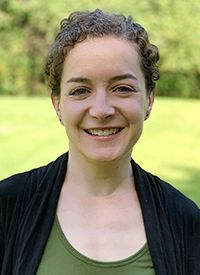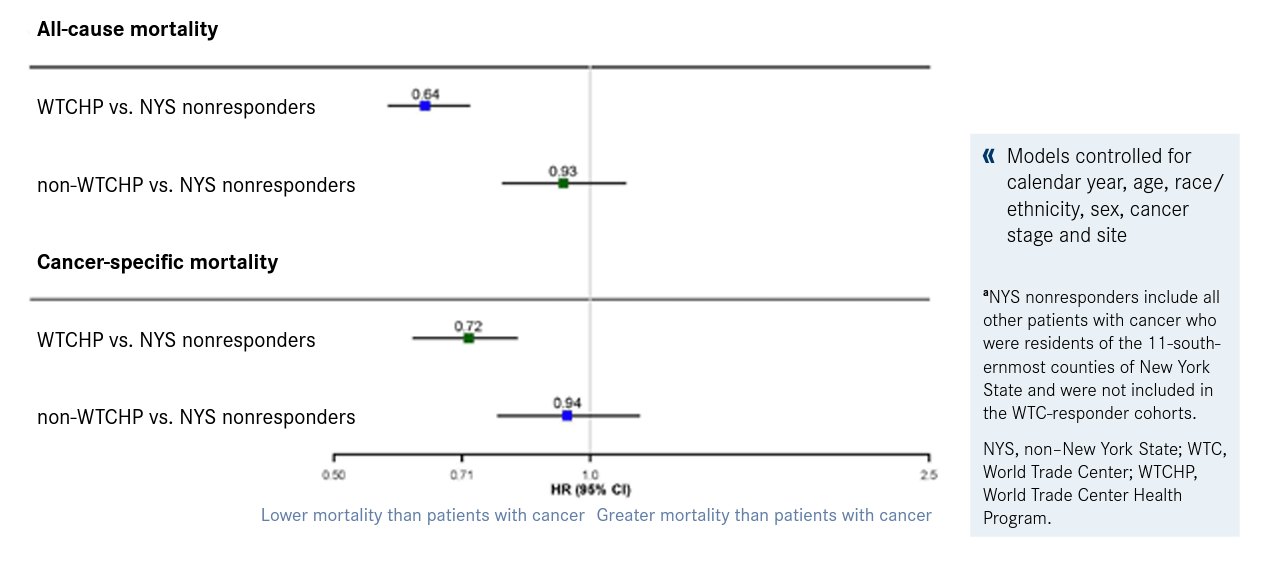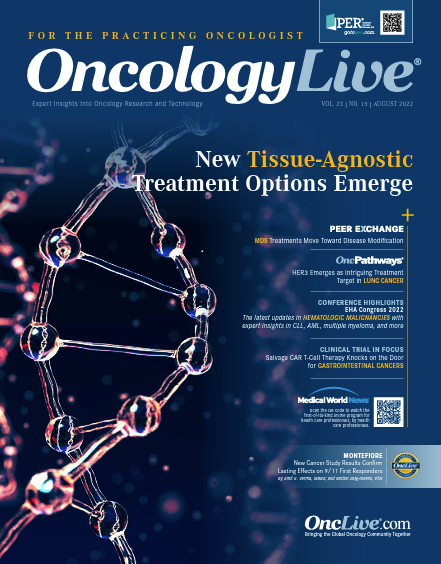Publication
Article
New Cancer Study Results Confirm Lasting Effects on 9/11 First Responders
Research investigating the physical and mental health consequences of being at the World Trade Center site during and after the terrorist attacks has been instrumental in obtaining health care coverage for thousands of individuals.
Rachel Zeig-Owens, DrPH, MPH

In the weeks after 9/11, the Fire Department of the City of New York (FDNY) World Trade Center (WTC) research team was established. The team is led by David J. Prezant, MD, a professor at Albert Einstein College of Medicine and chief medical officer for FDNY. It includes collaborators from FDNY, Montefiore Einstein Cancer Center, and New York University. Research investigating the physical and mental health consequences of being at the WTC site during and after the terrorist attacks has been instrumental in obtaining health care coverage for thousands of individuals. These exposures include known and suspected carcinogens such as asbestos, arsenic, polycyclic aromatic hydrocarbons, polychlorinated biphenyls, polychlorinated furans, and dioxins.1-6
Ten years ago, the FDNY WTC research team published the first study investigating cancer risk among FDNY firef ighters who worked at the WTC site.7 Over the past decade, this research has been expanded with nearly a dozen additional manuscripts about FDNY WTC–exposed rescue/recovery workers.8-15 During this time, additional studies from outside research teams have investigated cancer risk among other non-FDNY WTC-exposed rescue/recovery workers compared with the general population.16-18 These studies have produced some consistent findings.
In the studies, the incidence rates for all cancers combined were elevated compared with general population rates, although not all were statistically significant. Each study also reported elevated rates of prostate and thyroid cancer, but a reduced rate of lung cancer compared with the general population rates.7,16-18 Earlier in 2022, published findings from a study combining all of the WTC-exposure rescue/recovery worker cohorts showed that although the incidence rate for all cancers combined was no longer greater than the general population, the rates of prostate, thyroid, cutaneous melanoma, and tonsil cancer were elevated. Reduced rates were observed for several gastrointestinal, respiratory, and female reproductive cancers.19
Being that the FDNY cohort included mostly firefighters who were, on average, healthier than the general population but also exposed to carcinogens during routine firefighting activities, the question of whether the elevated rates were due to their occupational exposures rather than WTC exposures still needed to be answered. As part of the Career Firefighter Health Study, investigators compared FDNY firefighters with a cohort of non–WTC-exposed firefighters from Chicago, Illinois; Philadelphia, Pennsylvania; and San Francisco, California.20 The rate of prostate cancer was approximately 30% higher among FDNY firefighters, and the rate of thyroid cancer was more than 2-fold higher.8,21
Following the initial findings that cancer rates were elevated, the National Institute for Occupational Safety and Health assumed biologic plausibility to add most cancers to the list of conditions covered by the WTC Health Program.22 This addition meant that the WTC Health Program provided treatment of WTC-related cancers at no cost to the patient. It also meant that the WTC Health Program would begin free cancer screenings for eligible WTC-exposed responders and survivors enrolled in the WTCHP. The cancer screenings follow United States Preventive Services Task Force guidelines and include low-dose chest CT, colonoscopy, mammography, and Papanicolaou tests.22 For FDNY firefighters and emergency medical service (EMS) providers, as well as others, chest CT screening and other tests such as prostate-specific antigen (PSA) testing were provided by outside funds before 2012 when cancer was added to the WTC Health Program as a coverable condition. Members of the FDNY cohort still receive PSA testing via outside funding.
As noted above, elevated rates of thyroid cancer were observed.7,11,16-18 However, these data may be influenced by incidental detection related to this medical surveillance among WTC-exposed rescue/recovery workers.11 The elevated rate was only observed among individuals who were enrolled in the WTC Health Program.15 Further, 80% of the thyroid cancers diagnosed in the FDNY participants were asymptomatic at diagnosis and detected incidentally.11 Although the overall cancer rates may be elevated by the WTC Health Program screening, the care provided by the WTC Health Program may also be related to improved survival. Investigators found that among patients with cancer in the WTC Health Program, mortality was lower than the general population of patients with cancer, with cancer-specific mortality being 28% lower and all-cause mortality being 36% lower (Figure 1).21
Figure 1. All-Cause and Cancer-Specific Mortality Risk21

Between 2013 and 2015, investigators collected serum samples from thousands of FDNY WTC-exposed firefighters and EMS providers and created a biobank at Albert Einstein College of Medicine. Using samples from this biobank, investigators found that FDNY firefighters have an elevated rate of monoclonal gammopathy of undetermined significance (MGUS), the precursor disease to multiple myeloma, compared with the general population.9 In particular, the risk of light chain MGUS was 3 times higher, which may have important prognostic implications. Recently investigators expanded the study to include non-FDNY WTC-exposed rescue/ recovery workers. These analyses confirm the initial study and demonstrate an association between WTC exposure and MGUS.
The investigators’ recent study published in Nature Medicine also used samples from the biobank as well as samples collected from non–WTC-exposed firefighters.12 In this study, investigators conducted deep targeted sequencing of 237 genes frequently mutated in hematologic malignancies and then evaluated the relationship between WTC exposure and clonal hematopoiesis (CH)–associated mutations. CH is the acquisition of somatic mutations in blood cells in individuals without a hematologic malignancy, dysplasia, or cytopenia. CH-associated mutations with smoking and exposure to genotoxic stimuli increase the risk of leukemia and are associated with higher morbidity and mortality rates from a variety of inflammatory conditions and atherosclerotic cardiovascular disease.23-25 The results revealed that overall 10% of the FDNY WTC-exposed cohort (48 individuals out of 481 analyzed) had CH-associated mutations, compared with 6.7% (n = 17/255) in the non-WTC–exposed firefighter comparison cohort (Figure 2); investigators noted that with each subsequent decade the prevalence of pathogenic somatic mutations increases for both cohorts.
Figure 2. Prevalence of Somatic Mutations Seen in WTC-exposed First Responders

Investigators observed the odds of CH-associated mutations in the WTC-exposed first responders was more than 3-fold greater than in the non-WTC–exposed cohort (odds ratio, 3.12; 95% CI, 1.63-5.99; P = .0006) after controlling for age, sex, and race/ethnicity. This relationship between WTC exposure and CH-associated mutations held when investigators also controlled for smoking status. Smoking history was not significantly associated with the prevalence of pathogenic somatic mutations.
Genes implicated in CH-associated mutations and myeloid malignancies were those most frequently found to be mutated in the WTC-exposed cohort. The most identified variants affected DNMT3A (16 of 57) and TET2 (7 of 57). Other genes included those involving the spliceosome machinery, SF3B1, SRSF2 (3 of 57 each), as well as other genes commonly implicated in CH-associated mutations such as NRAS, TP53, MDM4, and MSH6 (2 of 57 for each gene, respectively). The pattern of CH-associated mutations was observed to be similar in the non–WTC-exposed firefighter cohort. Median variant allele frequency of the significant somatic mutations in WTC exposed cohort was 10%, consistent with other published CH studies. Missense mutations were most frequently identified. The most common base-pair change in the somatic mutations was a cytosine to thymine transition (C->T), considered a somatic mutational signature of aging 4. Analysis of overall mutational signatures in the WTC-exposed cohort demonstrated enrichment for aging, DNA mismatch repair, smoking, and alkylating agent.
This study also included in vivo analyses of wild-type mice exposed to WTC particulate matter. Overall, the genomic alterations observed in WTC particulate matter–exposed mice occurred at low variant allele frequencies throughout the whole genome indicating widespread genotoxic effects of aspirated WTC particulate matter on hematopoietic stem cells in vivo. These results demonstrate that environmental exposure to the WTC disaster site is associated with a higher burden of clonal hematopoiesis and provide rationale for mutational testing of the larger WTC-exposed population.
The team continues to investigate the association between WTC exposures and cancer in this population while also providing WTC health care practitioners study findings, cancer screening, and care. Only by continuing to conduct this kind of research and caring for the heroes who responded and assisted others during 9/11 will we begin to understand why certain first responders experience an elevated risk of certain cancers. These studies also ensure that the individuals who need it most get the most appropriate care.
We would like to acknowledge our team of collaborators including David J. Prezant, MD; Michael R. Savona, MD; Advaitha Madireddy, PhD; C. Ola Landgren, MD, PhD; Charles B. Hall, PhD; Michael D. Weiden, MD; David G. Goldfarb, MD; Mayris P. Webber, DrPh; and Anna Nolan, MD, MSc; as well as all the junior epidemiologists and analysts on our projects.
These studies were supported by National Institute for Occupational Safety and Health at the Centers for Disease Control and Prevention, Edward P. Evans Foundation, Valvano Foundation, Leukemia and Lymphoma Foundation, and the Jane and Myles P. Dempsey family.
Rachel Zeig-Owens, DrPH, MPH, is director of epidemiology and lead epidemiologist for the World Trade Center Health Program at the Fire Department of the City of New York, as well as an assistant professor in the Department of Epidemiology and Population Health at Albert Einstein College of Medicine in New York, New York.
Amit K. Verma, MBBS, is associate director of Translational Science at Montefiore Einstein Cancer Center and a professor in the Departments of Oncology; Medicine; and Developmental & Molecular Biology at Albert Einstein College of Medicine in New York, New York.
References
- Lioy PJ, Weisel CP, Millette JR, et al. Characterization of the dust/ smoke aerosol that settled east of the World Trade Center (WTC) in lower Manhattan after the collapse of the WTC 11 September 2001. Environ Health Perspect. 2002;110(7):703-714. doi:10.1289/ ehp.02110703
- Landrigan PJ, Lioy PJ, Thurston G, et al; NIEHS World Trade Center Working Group. Health and environmental consequences of the world trade center disaster. Environ Health Perspect. 2004;112(6):731-739. doi:10.1289/ehp.6702
- Lioy PJ, Georgopoulos P. The anatomy of the exposures that occurred around the World Trade Center site: 9/11 and beyond. Ann N Y Acad Sci. 2006;1076:54-79. doi:10.1196/annals.1371.002
- Lorber M, Gibb H, Grant L, Pinto J, Pleil J, Cleverly D. Assessment of inhalation exposures and potential health risks to the general population that resulted from the collapse of the World Trade Center towers. Risk Anal. 2007;27(5):1203-1221. doi:10.1111/j.15396924.2007.00956.x
- International Agency for Research on Cancer. IARC Monographs on the Evaluation of Carcinogenic Risks to Humans: Painting, Firefighting, and Shiftwork. IARC; 2010.
- National Toxicology Program. NTP 12th report on carcinogens. Rep Carcinog. 2011;12:iii-499.
- Zeig-Owens R, Webber MP, Hall CB, et al. Early assessment of cancer outcomes in New York City firefighters after the 9/11 attacks: an observational cohort study. Lancet. 2011;378(9794):898-905. doi:10.1016/S01406736(11)60989-6
- Moir W, Zeig-Owens R, Daniels RD, et al. Post-9/11 cancer incidence in World Trade Center-exposed New York City firefighters as compared to a pooled cohort of firefighters from San Francisco, Chicago and Philadelphia (9/11/2001-2009). Am J Ind Med. 2016;59(9):722-730. doi:10.1002/ajim.22635
- Landgren O, Zeig-Owens R, Giricz O, et al. Multiple Myeloma and Its Precursor Disease Among Firefighters Exposed to the World Trade Center disaster. JAMA Oncol. 2018;4(6):821-827. doi:10.1001/jamaoncol.2018.0509
- Webber MP, Singh A, Zeig-Owens R, et al. Cancer incidence in World Trade Center-exposed and non-exposed male firefighters, as compared with the US adult male population: 2001-2016. Occup Environ Med. 2021;78(10):707-714. doi:10.1136/ oemed-2021-107570
- Colbeth HL, Genere N, Hall CB, et al. Evaluation of medical surveillance and incidence of post-September 11, 2001, thyroid cancer in World Trade Center-exposed firefighters and emergency medical service workers. JAMA Intern Med. 2020;180(6):888-895. doi:10.1001/jamainternmed.2020.0950
- Jasra S, Giricz O, Zeig-Owens R, et al. High burden of clonal hematopoiesis in first responders exposed to the World Trade Center disaster. Nat Med. 2022;28(3):468-471. doi:10.1038/s41591-02201708-3
- Maura F, Diamond B, Maclachlan KH, et al. Initial whole-genome sequencing of plasma cell neoplasms in first responders and recovery workers exposed to the World Trade Center attack of September 11, 2001. Clin Cancer Res. 2021;27(7):2111-2118. doi:10.1158/1078-0432.CCR-20-2245
- Zeig-Owens R, Kablanian A, Webber MP, et al. Agreement between self-reported and confirmed cancer diagnoses in New York City firefighters and EMS workers, 2001-2011. Public Health Rep. 2016;131(1):153-159. doi:10.1177/003335491613100122
- Goldfarb DG, Colbeth HL, Skerker M, et al. Impact of healthcare services on thyroid cancer incidence among World Trade Center-exposed rescue and recovery workers. Am J Ind Med. 2021;64(10):861-872. doi:10.1002/ajim.23277
- Li J, Cone JE, Kahn AR, et al. Association between World Trade Center exposure and excess cancer risk. JAMA. 2012;308(23):24792488. doi:10.1001/jama.2012.110980
- Solan S, Wallenstein S, Shapiro M, et al. Cancer incidence in world trade center rescue and recovery workers, 2001-2008. Environ Health Perspect. 2013;121(6):699-704. doi:10.1289/ehp.1205894
- Shapiro MZ, Wallenstein SR, Dasaro CR, et al. Cancer in general responders participating in World Trade Center Health Programs, 2003-2013. JNCI Cancer Spectr. 2020;4(1):pkz090. doi:10.1093/ jncics/pkz090
- Li J, Yung J, Qiao B, et al. Cancer Incidence in World Trade Center Rescue and Recovery Workers: 14 Years of Follow-Up. J Natl Cancer Inst. 2022;114(2):210-219. doi:10.1093/jnci/djab165
- Zeig-Owens R, Singh A, Triplett S, et al. Assembling the Career Firefighter Health Study cohort: a methods overview. Am J Ind Med. 2021;64(8):680-687. doi:10.1002/ajim.23266
- Goldfarb DG, Zeig-Owens R, Kristjansson D, et al. Cancer survival among World Trade Center rescue and recovery workers: a collaborative cohort study. Am J Ind Med. 2021;64(10):815-826. doi:10.1002/ajim.23278
- Covered conditions. Centers for Disease Control and Prevention. Accessed July 20, 2022. https://www.cdc.gov/wtc/ conditions.html
- Bolton KL, Ptashkin RN, Gao T, et al. Cancer therapy shapes the fitness landscape of clonal hematopoiesis. Nat Genet. 2020;52(11):1219-1226. doi:10.1038/s41588-020-00710-0
- Zink F, Stacey SN, Norddahl GL, et al. Clonal hematopoiesis, with and without candidate driver mutations, is common in the elderly. Blood. 2017;130(6):742-752. doi:10.1182/blood-2017-02-769869
- Dawoud AAZ, Tapper WJ, Cross NCP. Clonal myelopoiesis in the UK Biobank cohort: ASXL1 mutations are strongly associated with smoking. Leukemia. 2020;34(10):2660-2672. doi:10.1038/ s41375-020-0896-8









